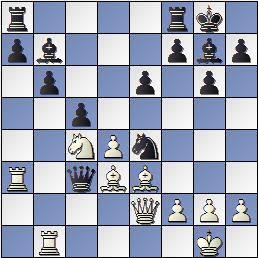I have been watching the Saint Louis Chess Club's YouTube coverage of the 2017 U.S. Chess Championships. In round 8, Ray Robson played a Gruenfeld Defense against Alexander Onischuk. After 1.d4 Nf6 2.c4 g6 3.Nc3 d5 4.cxd5 Nxd5 5.e4 Nxc3 6.bxc3 Bg7 7.Nf3 c5 8.Be3 Qa5 9.Qd2 0-0 10.Rc1 Nd7 11.Bd3 b6 12.0-0 e6 13.Qe2 Bb7 14.Nd2, they reached this positon:
Ray Robson decided to raid the two pawns at a2 and c3. I'm not sure where he thought he was getting away with the loot, but the tomb closed up and Ray's Raider got trapped 14...Qxa2 15.Ra1 Qb2 16.Rfb1 Qxc3 17.Nc4!
I think Onischuk speculated that Robson might have missed 17.Nc4. Play could have progressed with 17...b5 18.Ra3 Qb4 19.dxc5! Qxb1+ 20.Bxb1 bxc4 21.Qxc4 with only +1.15 pawns to White.
Instead, Robson tried to get out with 17...Nf6? 18.Ra3.It struck me here how similar the queen trap here is compared to the one in my own game. Not completely analogous, since I know there is a difference between Qb3 and Qc3. And now Robson played his own knight desperado 18...Nxe4
Unfortunately, the tactics are all in Onischuk's favor at this point. 19.Bxe4 Bxe4 20.Rxc3
Eventually, the game traded down to Queen and the 3 white kingside pawns versus Rook and the 4 black kingside pawns. Someone mentioned a fortress, but White forced some pawn exchanges and the Black king became too exposed to wait out the siege.





